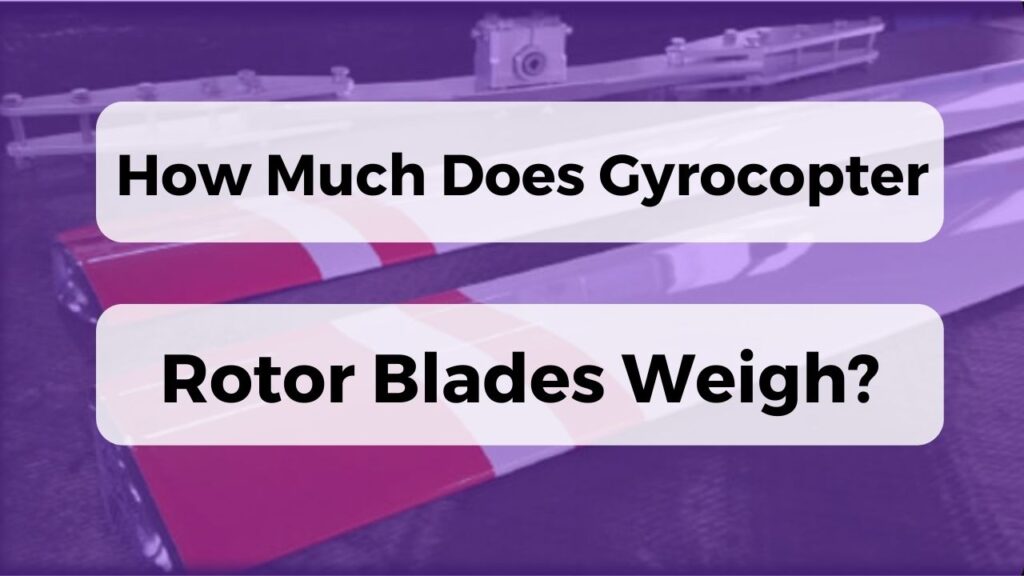Gyrocopters, also known as autogyros, have gained popularity in recent years due to their versatility and unique flying capabilities. These aircraft rely on rotor blades for lift and propulsion, making the weight of these components crucial for optimal performance. Did you know that the average weight of gyrocopter rotor blades is approximately 20-30 kilograms?
In this article, we will delve into the importance of gyrocopter rotor blade weight and its impact on overall flight dynamics. Advancements in rotor blade materials have allowed for lightweight designs that enhance maneuverability and fuel efficiency. Factors such as material selection, manufacturing techniques, and aerodynamic considerations greatly influence the final weight of these critical components.
We will explore common materials used in rotor blade construction, innovations in design techniques, and safety considerations related to rotor blade weight. Additionally, we will compare the weight of gyrocopter rotor blades with other aircraft components to provide a comprehensive understanding of their significance.
Join us as we unravel the science behind gyrocopter rotor blade weight and discover how it contributes to an exhilarating flying experience like no other.
Key Takeaways Of How Much Does Gyrocopter Rotor Blades Weigh?
- Gyrocopter rotor blades typically weigh between 20-30 kilograms on average.
- Advancements in rotor blade materials, such as carbon fiber composites, have allowed for lightweight designs without compromising structural integrity.
- Rotor blade weight significantly impacts flight stability, maneuverability, and safety considerations.
- Lightweight rotor blades contribute to improved handling, fuel efficiency, and payload capacity, making them essential for optimal gyrocopter performance.
The Importance of Gyrocopter Rotor Blades
You can’t underestimate the importance of gyrocopter rotor blades – they’re like the beating wings of a majestic bird, effortlessly slicing through the air. These vital components play a crucial role in the flight performance and stability of gyrocopters.
Gyrocopter rotor blades provide lift and propulsion by harnessing the power of the spinning rotor. Their design allows for efficient vertical takeoff and landing, making them advantageous in various applications such as search and rescue missions or recreational flying.
To ensure their optimal functionality, regular maintenance is essential. This includes inspecting for any signs of wear or damage, balancing the blades to prevent vibrations, and periodically lubricating critical parts.
Advancements in rotor blade materials have contributed to enhanced durability and performance, allowing gyrocopters to reach higher speeds and withstand more demanding flight conditions without compromising safety or efficiency.
Advancements in Rotor Blade Materials
The advancements in rotor blade materials bring a sense of awe and excitement to the audience. These developments have revolutionized the world of gyrocopters, particularly in terms of flight stability.
Engineers have been tirelessly working on finding new materials that offer improved strength-to-weight ratios, allowing gyrocopters to achieve enhanced performance while maintaining optimal safety standards. Lightweight carbon fiber composites have emerged as one of the most promising options due to their exceptional strength and durability. By reducing the weight of the rotor blades, these advancements enhance maneuverability and increase fuel efficiency.
Furthermore, the use of advanced materials also contributes to reduced vibrations during flight, resulting in a smoother and more comfortable experience for pilots and passengers alike. This focus on lightweight design for enhanced performance seamlessly transitions into the subsequent section about optimizing gyrocopter capabilities for various applications.
Lightweight Design for Enhanced Performance
Get ready to experience an exhilarating ride as we delve into the world of lightweight design, where enhanced performance takes center stage. In order to achieve maximum efficiency and maneuverability, gyrocopter rotor blades are specifically designed with lightweight materials and an aerodynamic shape.
These lightweight materials, such as carbon fiber composites and advanced alloys, help reduce the overall weight of the blades without compromising their strength or durability. Additionally, the aerodynamic shape of the rotor blades minimizes drag and improves lift capabilities, allowing for smoother operation and increased speed.
By incorporating these design elements, gyrocopters can achieve higher levels of agility and responsiveness in flight.
Moving forward into our discussion on factors affecting rotor blade weight…
Factors Affecting Rotor Blade Weight
In considering the weight of rotor blades, it becomes apparent that various factors significantly impact their overall mass and performance capabilities. One of the primary factors impacting blade efficiency is the material used in their construction. Lighter materials, such as carbon fiber composites, can be utilized to reduce weight without compromising strength or durability.
Additionally, advancements in manufacturing techniques have allowed for more precise and efficient blade designs, further reducing weight while maintaining aerodynamic performance. Another factor to consider is the length and shape of the rotor blades. Longer blades tend to be heavier due to increased surface area, while shorter blades reduce weight but may sacrifice lift capacity.
By optimizing these factors, engineers can achieve a balance between weight reduction and desired performance characteristics. These weight reduction techniques are crucial for enhancing gyrocopter maneuverability and fuel efficiency. Moving forward, understanding the common materials used in rotor blade construction will provide insight into their overall design and capabilities without compromising safety or reliability.
Common Materials Used in Rotor Blade Construction
Using lightweight materials in rotor blade construction is like adding wings to a dream, allowing gyrocopters to soar effortlessly through the sky. The choice of materials plays a crucial role in determining the performance of gyrocopters.
Common materials used in rotor blade construction include:
- Carbon fiber: Known for its exceptional strength-to-weight ratio, carbon fiber is commonly used in high-performance gyrocopter rotor blades. It offers excellent stiffness and durability while keeping the weight minimal.
- Fiberglass: This material is widely used due to its affordability and relatively good strength. Although not as lightweight as carbon fiber, fiberglass provides adequate performance for many gyrocopter applications.
- Aluminum alloy: Offering a balance between strength and weight, aluminum alloy rotor blades are commonly found on entry-level or recreational gyrocopters. They provide sufficient performance at a lower cost compared to carbon fiber or fiberglass.
The selection of these materials ensures optimal gyrocopter performance by reducing weight and increasing maneuverability.
Transitioning into the subsequent section about the role of rotor blade weight in flight stability, it becomes evident that understanding the impact of rotor blade weight is essential for ensuring safe flight operations.
The Role of Rotor Blade Weight in Flight Stability
The weight of rotor blades significantly impacts the stability of flight. A gyrocopter’s maneuverability is directly affected by the weight of its rotor blades. Lighter rotor blades allow for more nimble and agile movements, while heavier ones can limit the aircraft’s ability to perform quick maneuvers.
Additionally, the relationship between rotor blade weight and fuel consumption is an important consideration in aircraft design. Heavier blades require more power to rotate, resulting in increased fuel consumption. Therefore, finding a balance between a lightweight design for maneuverability and a sufficient weight for stability is crucial in optimizing flight performance.
Innovations in rotor blade design have focused on reducing weight without compromising strength and durability, allowing for improved maneuverability and fuel efficiency. Transitioning into the subsequent section about ‘innovations in rotor blade design,’ advancements have led to significant improvements in both performance and safety.
Innovations in Rotor Blade Design
Revolutionary advancements in rotor blade design have sparked a sense of awe and wonder, transforming the way we perceive flight. Innovations in rotor blade manufacturing have played a crucial role in improving the performance and efficiency of gyrocopters.
One key area of focus has been reducing the weight of rotor blades while maintaining their structural integrity. Lighter blades not only enhance maneuverability but also significantly impact fuel efficiency by reducing drag and increasing lift-to-weight ratio. Manufacturers are now utilizing cutting-edge materials such as carbon fiber composites to achieve this goal. These materials offer high strength-to-weight ratios, allowing for lighter yet durable rotor blades.
Additionally, advanced manufacturing techniques like 3D printing enable intricate designs that optimize aerodynamics further. As we delve into safety considerations for rotor blade weight, it becomes evident that these innovations have revolutionized the industry, paving the way for greater possibilities in flight technology and efficiency.
Safety Considerations for Rotor Blade Weight
Innovations in rotor blade design have led to significant improvements in the performance and efficiency of gyrocopters. However, safety considerations must also be taken into account when it comes to rotor blade weight. Rotor blades that are too heavy can negatively impact the maneuverability of the aircraft and increase the risk of accidents. Therefore, safety regulations dictate that gyrocopter rotor blades must meet specific weight requirements to ensure optimal performance and safe operation.
The weight of gyrocopter rotor blades is carefully calculated to strike a balance between strength and maneuverability. Manufacturers use advanced materials such as carbon fiber composites to reduce weight without compromising structural integrity. By reducing the weight of the rotor blades, pilots can enjoy greater control over their gyrocopters while still maintaining the necessary stability.
Considering these safety regulations and their impact on maneuverability, it is crucial for gyrocopter owners and operators to adhere to these guidelines to ensure safe flying experiences.
Now let’s explore how the weight of gyrocopter rotor blades compares with other components found in aircraft.
Weight Comparisons with Other Aircraft Components
When it comes to comparing the weight of gyrocopter rotor blades with other aircraft components, you’ll find that they are as light as a feather in comparison. Gyrocopter rotor blades weigh significantly less than other components due to their design and function. Here are some weight comparisons to give you a better understanding:
- The engine of a typical gyrocopter can weigh anywhere from 150 to 300 pounds.
- The fuselage, which houses the pilot and passengers, can weigh around 200 to 400 pounds.
- The landing gear system weighs approximately 50 to 100 pounds.
In contrast, gyrocopter rotor blades typically weigh around 20 to 30 pounds each. This immense difference in weight allows for greater maneuverability and agility during flight.
With lightweight rotor blades, gyrocopters can achieve optimal performance, including improved handling and fuel efficiency. These factors contribute to its growing popularity among aviation enthusiasts seeking an exhilarating flying experience without compromising safety and control.
Conclusion: Lightweight Rotor Blades for Optimal Gyrocopter Performance
Experience the exhilaration of optimal gyrocopter performance with lightweight rotor blades, allowing for greater maneuverability and agility in flight. The weight of the rotor blades plays a crucial role in determining the overall performance of a gyrocopter.
By utilizing lightweight rotor blade materials, such as carbon fiber or composite materials, manufacturers are able to reduce the weight of the blades without compromising their strength and durability. This reduction in weight has a significant impact on the maneuverability of the gyrocopter, as it allows for quicker response times and more precise control during flight.
Additionally, lighter rotor blades also contribute to improved fuel efficiency and increased payload capacity. Overall, investing in lightweight rotor blades is essential for achieving optimal gyrocopter performance and enhancing the pilot’s flying experience.
Frequently Asked Questions
How does the weight of gyrocopter rotor blades affect the performance of the aircraft?
The weight of gyrocopter rotor blades significantly impacts maneuverability and fuel efficiency. A lighter blade allows for easier maneuvering and reduces drag, leading to improved performance and lower fuel consumption.
What are the factors that contribute to the weight of rotor blades?
The weight of gyrocopter rotor blades is influenced by various factors, such as material choice, blade length, and design complexity. To reduce weight without compromising performance, engineers can utilize lightweight materials and optimize the blade’s structure for efficiency.
Are there any safety considerations related to the weight of rotor blades?
Safety considerations related to the weight of rotor blades include ensuring proper balance and stability during flight. Excessive weight can negatively impact blade durability, leading to potential structural failures and increased risk of accidents.
How do the materials used in rotor blade construction affect their weight?
The materials used in rotor blade construction significantly affect their weight. The effect of blade shape and the importance of weight distribution should be considered to optimize performance and stability.
How does the weight of rotor blades compare to other components of a gyrocopter?
Rotor blade weight significantly impacts gyrocopter maneuverability. Lighter blades allow for better agility and responsiveness, while heavier blades can reduce performance. Maintenance requirements include regular inspections, balancing, and ensuring proper torque on blade bolts.
Conclusion
In conclusion, lightweight rotor blades are essential for optimal gyrocopter performance. The advancements in rotor blade materials have allowed for a more efficient and agile flying experience. By reducing the weight of the blades, gyrocopters can achieve higher speeds and improved maneuverability.
It’s important to consider safety considerations when determining the weight of the rotor blades, as they play a crucial role in maintaining stability during flight. Compared to other aircraft components, rotor blades must be carefully designed and constructed using common materials that offer strength without compromising on weight.
Overall, investing in innovative designs and utilizing lightweight materials will ensure an enhanced gyrocopter experience for pilots.



